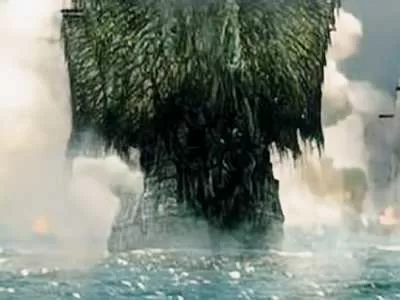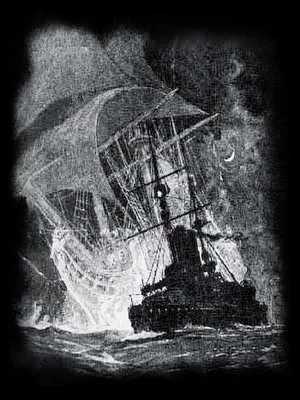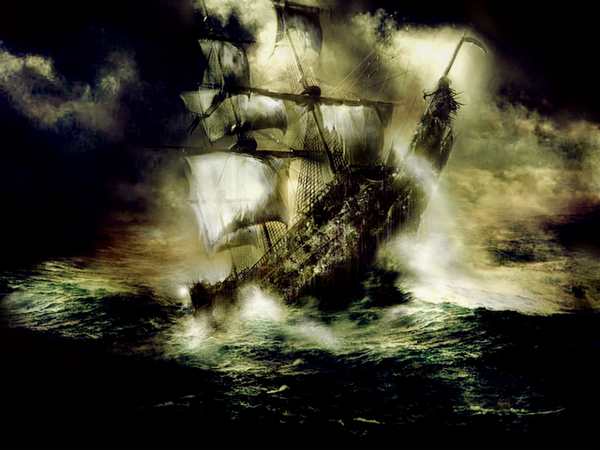If you’ve heard of Captain Jack Sparrow, you’re likely familiar with the “Flying Dutchman.” Though the “Pirates of the Caribbean” movies touch on this eerie legend, the real story is rooted in centuries-old maritime folklore. Far from just a creation of screenwriters and visual effects artists, the Flying Dutchman has haunted sailors’ imaginations for generations, predating even the most notorious pirates.
The Legend of the Flying Dutchman
The tale of the Flying Dutchman is akin to the ghost stories told around a campfire, meant to thrill and chill listeners. Sailors would recount sightings of the ghostly ship during foggy nights or in treacherous waters known for mysterious disappearances. Much like the real-life maritime mystery of the Mary Celeste, these stories would only add to the allure and fear surrounding the legend of the Flying Dutchman.
The legend commonly describes the Flying Dutchman as a ghost ship that foretells doom. The first written account of this legend dates back to 1795 when Irish writer George Barrington penned “Voyage to Botany Bay.” According to his narrative, sailors spoke of a Dutch Man-of-War lost in a violent storm. This spectral vessel, they claimed, would reappear in foggy conditions, causing shipwrecks and chaos.
One possible inspiration for the captain of the Flying Dutchman is Bernard Fokke, a Dutch sailor reputed for making impossibly fast voyages between Holland and Java. Some speculated that Fokke was in league with the Devil, making him a fitting candidate for the ghost ship’s cursed captain. Throughout the years, numerous sightings of the Flying Dutchman have been reported near the Cape of Good Hope and other treacherous maritime locations.

Scientific Explanations
Modern science offers a more rational explanation for these ghostly sightings. The phenomenon known as Fata Morgana—a type of mirage named after the sorceress Morgana Le Fay—occurs when warm air rests above a layer of cold air over the ocean. This creates a refracting lens effect, producing a distorted and often upside-down image of an object beyond the horizon. Ships viewed through this mirage can appear larger, closer, and eerier than they are, leading to reports of phantom vessels.
The Tale’s Enduring Legacy
Despite scientific explanations, the legend of the Flying Dutchman continues to capture the imagination of sailors, filmmakers, and writers. Like the headless horseman of Sleepy Hollow or the monsters in “The Village,” the Flying Dutchman serves to entertain, frighten, and remind us of the mysteries that lie beyond the edge of the known world. While modern tales like “Pirates of the Caribbean” introduce fantastical elements such as giant sea monsters, the core of the Flying Dutchman legend remains a warning of impending disaster.
Documented Sightings of the Flying Dutchman
Though many consider the Flying Dutchman a myth, credible witnesses have reported seeing the ghost ship, particularly near the Cape of Good Hope. Here are some notable sightings:
- 1823: Captain Owen of the HMS Leven recorded two sightings in his logbook.
- 1835: Crew members of a British vessel reported seeing a ship approaching during a storm, only for it to vanish before collision.
- 1881: Three crew members of the HMS Bacchante, including future King George V, saw the ship. One of the men died the next day after falling from the rigging.
- 1879: Crew members of the SS Pretoria reported seeing the ghost ship.
- 1911: A whaling ship nearly collided with the Flying Dutchman before it disappeared.
- 1923: British Navy members documented a 15-minute sighting, later submitted to the Society for Psychical Research.
- 1939: Observers ashore at Glencairn Beach saw the ship, and U-boat crews during World War II logged similar sightings.
- 1941: The Flying Dutchman was sighted entering Table Bay before vanishing.
- 1942: Witnesses saw the ship near HMS Jubilee, which was recorded in the ship’s log.
- 1959: The Straat Magelhaen nearly collided with the ghost ship.

Origins of the Legend
The Flying Dutchman legend is said to have begun in 1641 when a Dutch ship sank off the Cape of Good Hope. Captain Hendrik van der Decken, the ship’s master, allegedly cursed himself and his ship to sail the seas for eternity after encountering a fierce storm. According to the tale, whenever a storm brews off the Cape, the ghostly ship can be seen, and those who witness it are doomed to a terrible fate.
One of the most famous sightings occurred on July 11, 1881. The Royal Navy ship Bacchante encountered the Flying Dutchman while rounding the tip of Africa. The midshipman, a prince who would later become King George V, documented the event, describing a ghostly red light illuminating the phantom ship. Tragically, the lookout who first saw the ship fell to his death shortly after the sighting, adding to the legend’s ominous reputation.
The legend of the Flying Dutchman continues to fascinate and terrify, serving as a timeless reminder of the sea’s unpredictable and often perilous nature. Whether a myth or a misinterpreted natural phenomenon, the ghost ship endures in maritime lore, haunting the waves and the imaginations of those who dare to venture into the unknown.
Post Highlights: Flying Dutchman legend, Ghost ship sightings, Maritime folklore, Cape of Good Hope ghost ship, Fata Morgana mirage, Haunted seas, Hendrik van der Decken, King George V ghost ship, Phantom ship sightings, Historical maritime mysteries,

